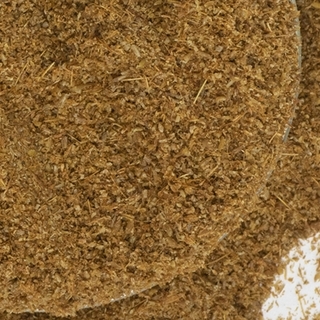Ground Cumin




Ground Cumin
Ground Cumin (pronounced "khu-min"), Cuminum cyminum, is also called cumin powder, cumin spice or cumin seasoning.
Cumin has an essential oil content of between 2.5% to 4.5%.
Ground cumin is made by grinding whole cumin seeds. Because of its high volatile oil content, it is best to use freshly ground cumin for maximum flavor. We grind cumin several times a week in our facility for peak freshness. We also prefer a slightly coarser grind as the finer the grind, the more surface area of the spice is exposed, which leads to quicker degradation of flavor.
Cumin is closely related to anise, caraway, coriander, dill, and fennel. Native to the Mediterranean and northern Africa, cumin is one of the most commonly consumed spices worldwide, right after chiles and pepper.
A key spice in Indian, Mexican, and Vietnamese cuisine, it wasn’t until the 1960s, with the rise of Taco Bell, that cumin started gaining prominence in the United States. Cumin is popular with our craft sauce manufacturers, Mexican restaurants, and independent spice shops.
Flavor Profile
Ground Cumin has a distinctive flavor with an earthy, nutty, spicy taste, somewhat bitter undertones, and a warm, penetrating aroma with hints of lemon.
It is not the same sort of spicy that you would say black pepper or chiles are, but it does have an intensity.
How to Use
Cumin has long been a signature spice for cooks in the Far East, Latin America, Mexico, the Middle East, and North Africa. It is a key ingredient in various spice blends and many beans, couscous, curry, rice, and vegetable dishes. We recommend using cumin sparingly as it is quite potent and can easily overwhelm a dish.
Some of our favorite recipes using cumin are Moorish Pork Skewers, Flat Iron Steak, and Chipotle Cumin Gourmet Ketchup.
Cumin shines when added to beans, bread, cabbage, pungent cheeses, chicken, eggplant, lamb, lentils, onions, potatoes, rice, sauerkraut, and squash.
Cumin works well with spices like allspice, anise seed, brown mustard, cardamom, cinnamon, coriander, fennel, fenugreek, garlic, ginger, nutmeg, paprika, turmeric, and yellow mustard.
Cumin is one of those spices that doesn't have a flavor equivalent. In some recipes, if you are looking for a bit of earthiness and don't mind a little extra color, you can substitute cumin with turmeric. Some people say that caraway seed is a good substitute because of its potency, but it has a very different flavor profile and might not suit your recipe well.
Add these substitutes with caution, tasting often.
| Ingredients | Cumin Seeds |
| Also Called | Cumin powder, cumin spice, or cumin seasoning |
| Recommended Uses | Use with beans, bread, cabbage, pungent cheeses, chicken, eggplant, lamb, lentils, onions, potatoes, rice, sauerkraut, and squash |
| Flavor Profile | Earthy, nutty, spicy taste with somewhat bitter undertones and a warm, penetrating aroma with hints of lemon |
| Oil Content | 2.5% 4.5% |
| Botanical Name | Cuminum cyminum |
| Cuisine | Africa, Indian, Latin American, Mexican, and Vietnamese |
| How To Store | Airtight container in a cool, dark place |
| Shelf Life | 6-12 Months |
| Country of Origin | India |
Nutrition Facts
Serving Size1 tsp
Amount Per Serving
Calories11
% Daily Value*
Total Fat1g1%
Saturated Fat0g0%
Trans Fat0g
Polyunsaturated Fat0g
Monounsaturated Fat0g
Cholesterol0mg0%
Sodium5.0mg0%
Total Carbohydrate1.3g0%
Dietary Fiber0.3g1%
Total Sugars0.1g
Added Sugars0g0%
Sugar Alcohol0.0g
Protein0.5g1%
Vitamin D0mcg0%
Calcium27mg2%
Iron2mg11%
Potassium52mg1%
*The % Daily Value (DV) tells you how much a nutrient in a serving of food contributes to a daily diet. 2,000 calories a day is used for general nutrition advice. These values were calculated and therefore are approximate. For more accuracy, testing is advised.
























